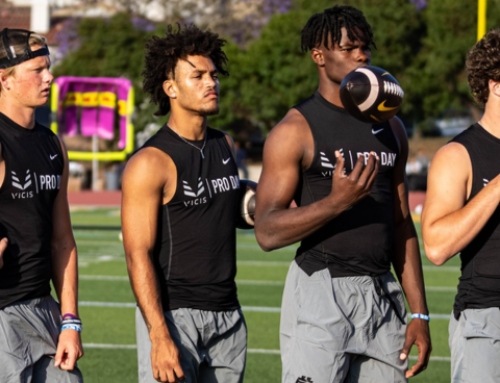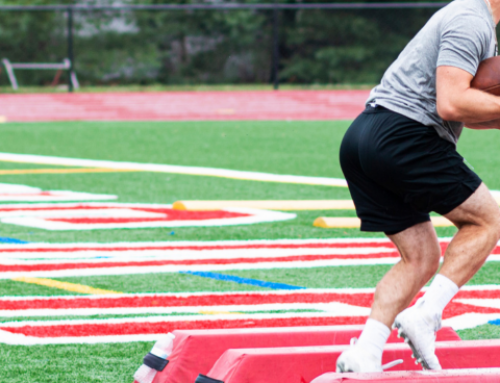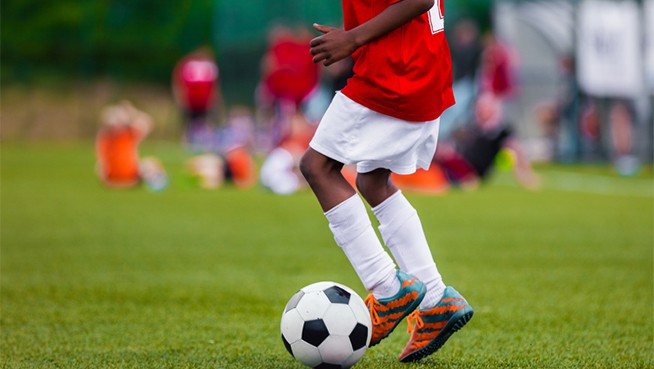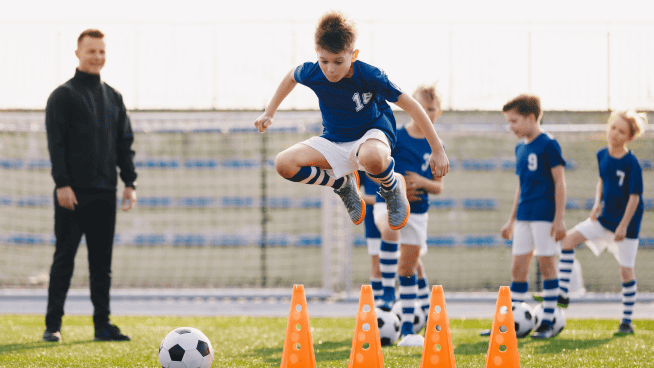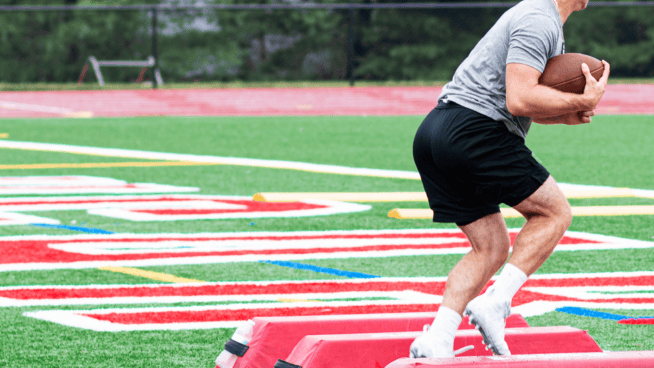Here’s The New Tackling Technique That’s Revolutionizing Football Safety
Head injuries are changing the game of football.
As researchers learn more about the long-term impacts of concussions and sub-concussive hits, the true dangers of playing football have come to light. Although several rule changes have been made over the last decade to make the game safer, concussions are still occurring at an alarming rate. A huge number of parents—including President Obama and Troy Aikman—have said they would not let their children play football as it exists today.
But how do we change it?
No one wants to turn tackle football into flag football, but almost everyone agrees we need to make it safer. What if I told you a minor tweak in traditional tackling technique could drastically reduce head impacts without compromising the physical nature of the game? And not only that, it could also help players tackle more effectively? It sounds too good to be true, but a certain NFL team and a growing body of research are finding that rugby-inspired tackling can change football for the better.
The Problem With Traditional Tackling Technique
Traditional tackling technique—the type I and most kids born in the 80s and early 90s learned growing up—emphasized putting your head in front of the ballcarrier when making the tackle. Essentially, I was taught to always have my head on the upfield side of the ballcarrier.
I don’t remember ever hearing an explanation for or the reasons behind this technique, but I always thought it was so your head could be like an extra limb—helping to impede the ballcarrier’s progress and put you in a position to use most of your body to make the tackle. On the flip side, I thought placing my head behind the ballcarrier would turn my technique into an arm-tackle; and all the carrier had to do to break the tackle was run through my arm. Placing my head in front allowed me to put as much of myself as possible between the ballcarrier and the end zone.
But in recent years, tackling techniques have started to change. The desire to reduce head impacts in football has driven the changes, but there has yet to be a consensus on the best way to teach tackling. However, a technique called “Hawk” tackling, which is based on rugby, seems to be getting some incredibly encouraging results.
The Seahawks’ Tackling System

“Hawk” tackling is what the Seattle Seahawks call the tackling technique they teach and employ.
Largely the brainchild of Rocky Seto, an assistant head coach for Seattle who was also on Pete Carroll’s staff at USC, it eschews traditional football tackling methods in favor of a rugby-style approach. Since they don’t wear helmets, rugby players should experience more head trauma and concussions than football players, but the opposite is true. Since they don’t have helmets to protect themselves, they’ve learned how to tackle effectively while taking their head almost entirely out of the equation.
“I believe that’s how the game was originally played, when the guys were wearing leather helmets or the helmets without the face masks,” Seto recently told ESPN. “You didn’t want to put your nose right into someone’s chest or knee. You’re going to get hurt. So that’s just what the rugby guys do, as well. They try to get contact with the shoulders. That’s the biggest principle.”
RELATED: Meet Kaylin Ponga, A 16-year-old Australian Rugby Player Who Could Play in the NFL
When tackling with the shoulder, the emphasis on placing the head in front of the ballcarrier is drastically reduced. The major points of “Hawk” tackling include tracking the near the hip, maintaining leverage, hitting the thighs of the ballcarrier with the leverage shoulder, wrapping up and driving for five steps if necessary. Here’s what a textbook “Hawk” tackle looks like:
“Conventional football is to get your head across or to see what you hit, essentially using your head as a limb to stop guys from coming forward,” Seto said. The Seahawks still occasionally make tackles where their head is in front of the ballcarrier, but they’re never taught to use it as a limb.
In a recent instructional video created by the Seahawks to teach their tackling technique, Carroll narrates, “to summarize, our tackling system features leverage-based shoulder tackling and a major emphasis on taking the head out of tackling.” I cannot urge you enough to watch this 2015 video, which features highlights, drills and extensive narration by Carroll. It explains the finer points of the “Hawk” tackling system better than I ever could.
Safe, Sure Tackling

It’s all nice and good that the Seahawks developed a tackling system, but it wouldn’t be spreading like wildfire if it didn’t get results. Seto and Carroll developed the technique because they believed it was the most effective way to tackle. They quickly found that the most effective way to tackle might also be the safest.
Over the last three seasons, the Seahawks have limited ballcarriers to an average of 4.38 yards after catches and an average of 1.5 yards after contact, which rank best and fifth-best in the NFL, respectively. Their sure-tackling is one big reason why the their defense consistently suffocates opposing offenses.
RELATED: Seahawks DL Michael Bennett’s Explosive Training Secret
According to the Frontline PBS Concussion Watch website, only one Seahawks defensive player suffered a concussion in 2015. That tied them for the second-fewest concussions by defensive players in the league. Only the Tennessee Titans had fewer. In 2014, just two Seahawks defensive players suffered concussions. In 2013, two. In 2012, one.
These numbers show that the Seahawks’ style of tackling is safer and more effective. But so does recent scientific research on the issue. We recently wrote about a study published in The Journal of Athletic Training that found a helmetless practice program can both lead to a significant reduction in head injuries and improve tackling effectiveness.
RELATED: Research Shows Practice Without Helmets Can Reduce Concussions and Improve Tackling Ability
In the study, football players at the University of New Hampshire regularly went through a series of specially-designed tackling drills without a helmet. The drills were inspired by rugby tackling techniques. Half the players performed no helmet drills leading up to and throughout the season, while the other half practiced as they normally did. Throughout the season, all players wore helmets equipped with censors to measure head impacts. By the final week of the season, the group that had performed regular helmetless practice were getting hit in the head 30 percent less often than the players who never took their helmets off.
In the Seahawks’ instructional video, the players perform nearly all of their tackling drills without helmets. It’s impossible to say that the UNH players performed identical drills (the researchers didn’t release such data), but their rugby-inspired nature leads me to believe they were similar. It is easy to tell a player “don’t use your head when you tackle,” but that’s probably not going to make much of a difference. Drilling the proper technique and creating muscle memory are the real keys to changing habits and the way players approach tackling.
The evidence showing that rugby-style tackling is both safer and more effective than traditional tackling continues to grow. Some concussions are inevitable due to the nature of the sport, but this seems like a big step in the right direction. We’ll be keeping an eye on the new research and implementation of these tackling techniques in the months ahead.

RECOMMENDED FOR YOU
MOST POPULAR
Here’s The New Tackling Technique That’s Revolutionizing Football Safety
Head injuries are changing the game of football.
As researchers learn more about the long-term impacts of concussions and sub-concussive hits, the true dangers of playing football have come to light. Although several rule changes have been made over the last decade to make the game safer, concussions are still occurring at an alarming rate. A huge number of parents—including President Obama and Troy Aikman—have said they would not let their children play football as it exists today.
But how do we change it?
No one wants to turn tackle football into flag football, but almost everyone agrees we need to make it safer. What if I told you a minor tweak in traditional tackling technique could drastically reduce head impacts without compromising the physical nature of the game? And not only that, it could also help players tackle more effectively? It sounds too good to be true, but a certain NFL team and a growing body of research are finding that rugby-inspired tackling can change football for the better.
The Problem With Traditional Tackling Technique
Traditional tackling technique—the type I and most kids born in the 80s and early 90s learned growing up—emphasized putting your head in front of the ballcarrier when making the tackle. Essentially, I was taught to always have my head on the upfield side of the ballcarrier.
I don’t remember ever hearing an explanation for or the reasons behind this technique, but I always thought it was so your head could be like an extra limb—helping to impede the ballcarrier’s progress and put you in a position to use most of your body to make the tackle. On the flip side, I thought placing my head behind the ballcarrier would turn my technique into an arm-tackle; and all the carrier had to do to break the tackle was run through my arm. Placing my head in front allowed me to put as much of myself as possible between the ballcarrier and the end zone.
But in recent years, tackling techniques have started to change. The desire to reduce head impacts in football has driven the changes, but there has yet to be a consensus on the best way to teach tackling. However, a technique called “Hawk” tackling, which is based on rugby, seems to be getting some incredibly encouraging results.
The Seahawks’ Tackling System

“Hawk” tackling is what the Seattle Seahawks call the tackling technique they teach and employ.
Largely the brainchild of Rocky Seto, an assistant head coach for Seattle who was also on Pete Carroll’s staff at USC, it eschews traditional football tackling methods in favor of a rugby-style approach. Since they don’t wear helmets, rugby players should experience more head trauma and concussions than football players, but the opposite is true. Since they don’t have helmets to protect themselves, they’ve learned how to tackle effectively while taking their head almost entirely out of the equation.
“I believe that’s how the game was originally played, when the guys were wearing leather helmets or the helmets without the face masks,” Seto recently told ESPN. “You didn’t want to put your nose right into someone’s chest or knee. You’re going to get hurt. So that’s just what the rugby guys do, as well. They try to get contact with the shoulders. That’s the biggest principle.”
RELATED: Meet Kaylin Ponga, A 16-year-old Australian Rugby Player Who Could Play in the NFL
When tackling with the shoulder, the emphasis on placing the head in front of the ballcarrier is drastically reduced. The major points of “Hawk” tackling include tracking the near the hip, maintaining leverage, hitting the thighs of the ballcarrier with the leverage shoulder, wrapping up and driving for five steps if necessary. Here’s what a textbook “Hawk” tackle looks like:
“Conventional football is to get your head across or to see what you hit, essentially using your head as a limb to stop guys from coming forward,” Seto said. The Seahawks still occasionally make tackles where their head is in front of the ballcarrier, but they’re never taught to use it as a limb.
In a recent instructional video created by the Seahawks to teach their tackling technique, Carroll narrates, “to summarize, our tackling system features leverage-based shoulder tackling and a major emphasis on taking the head out of tackling.” I cannot urge you enough to watch this 2015 video, which features highlights, drills and extensive narration by Carroll. It explains the finer points of the “Hawk” tackling system better than I ever could.
Safe, Sure Tackling

It’s all nice and good that the Seahawks developed a tackling system, but it wouldn’t be spreading like wildfire if it didn’t get results. Seto and Carroll developed the technique because they believed it was the most effective way to tackle. They quickly found that the most effective way to tackle might also be the safest.
Over the last three seasons, the Seahawks have limited ballcarriers to an average of 4.38 yards after catches and an average of 1.5 yards after contact, which rank best and fifth-best in the NFL, respectively. Their sure-tackling is one big reason why the their defense consistently suffocates opposing offenses.
RELATED: Seahawks DL Michael Bennett’s Explosive Training Secret
According to the Frontline PBS Concussion Watch website, only one Seahawks defensive player suffered a concussion in 2015. That tied them for the second-fewest concussions by defensive players in the league. Only the Tennessee Titans had fewer. In 2014, just two Seahawks defensive players suffered concussions. In 2013, two. In 2012, one.
These numbers show that the Seahawks’ style of tackling is safer and more effective. But so does recent scientific research on the issue. We recently wrote about a study published in The Journal of Athletic Training that found a helmetless practice program can both lead to a significant reduction in head injuries and improve tackling effectiveness.
RELATED: Research Shows Practice Without Helmets Can Reduce Concussions and Improve Tackling Ability
In the study, football players at the University of New Hampshire regularly went through a series of specially-designed tackling drills without a helmet. The drills were inspired by rugby tackling techniques. Half the players performed no helmet drills leading up to and throughout the season, while the other half practiced as they normally did. Throughout the season, all players wore helmets equipped with censors to measure head impacts. By the final week of the season, the group that had performed regular helmetless practice were getting hit in the head 30 percent less often than the players who never took their helmets off.
In the Seahawks’ instructional video, the players perform nearly all of their tackling drills without helmets. It’s impossible to say that the UNH players performed identical drills (the researchers didn’t release such data), but their rugby-inspired nature leads me to believe they were similar. It is easy to tell a player “don’t use your head when you tackle,” but that’s probably not going to make much of a difference. Drilling the proper technique and creating muscle memory are the real keys to changing habits and the way players approach tackling.
The evidence showing that rugby-style tackling is both safer and more effective than traditional tackling continues to grow. Some concussions are inevitable due to the nature of the sport, but this seems like a big step in the right direction. We’ll be keeping an eye on the new research and implementation of these tackling techniques in the months ahead.


